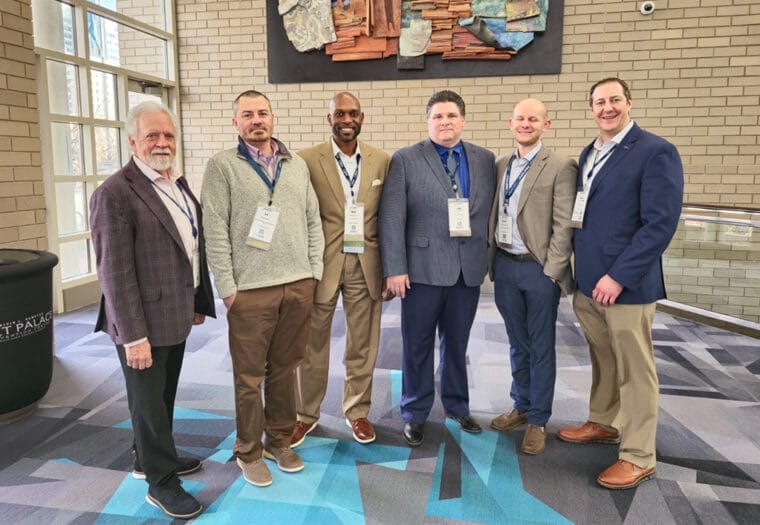Insight | Mar 20, 2024 | Christyn Binder
Insights from the 2024 AAAE/ACC Airport Symposium
The 2024 AAAE/Airports Consultants Council (ACC) Airport Planning, Design, and Construction Symposium (APDC), held in Salt Lake City from March 5-7, brought together aviation experts and industry leaders to discuss the latest developments, challenges, and best practices in the field of airport planning, design, and construction.
The Arora Engineers (Arora) team joined 1,800+ of our colleagues at the 2024 APDC– the most well-attended conference in its 30+ year history! Across three days of dynamic presentations, experts in Aviation delved into important industry advancements and challenges while exploring cutting-edge technologies with topics ranging from the implementation of AI into airport operations and infrastructure, advanced air mobility, preparations for Olympics games, improving sustainability to meet the goals of the US Aviation Climate Action Plan, prioritizing diversity, equity, and inclusion, and so much more. The Arora team is excited to share our key takeaways from the 2024 Symposium.
Enhancing Sustainability & Passenger Experience
Sessions presented for the Terminal/Landside track highlighted a growing trend in sustainable airport designs, highlighted in the session on “Innovation in Aviation: The Future of Mass Timber.” The panel, comprising Builder and A&E Design Firms, explored the practical, aesthetic, and sustainable possibilities of incorporating mass timber in capital improvement programs. Further, the workshop on “PDX Terminal Core Redevelopment – Roof Installation and Update” provided insights into sustainable construction practices, specifically innovative roof installation techniques over existing terminal buildings.
The “Digital Identification Program for Check-in” session highlighted developments in touchless self-service processing, underscoring the industry’s dedication to sustainability and innovative technology. “Wheels-up: The New Flight Path for Post-Pandemic Terminals” addressed evolving passenger needs and highlighted the importance of forward-thinking design practices.
Lastly, “Innovative Blending of Art and Immersive Multimedia to Create a Sense of Place” demonstrated airports’ creative embrace of sustainable and innovative design strategies, integrating art and multimedia technologies to enrich the passenger experience while reflecting local culture. The collective sessions accentuated the sustainable practices and forward-thinking designs shaping the future of aviation infrastructure.
Navigating Transformations in Project & Construction Management
Informative sessions across the PM/CM track discussed project and construction management in the dynamic landscape of the aviation sector. Sessions like “Integration Done Right – The Design-Builder’s Guide to Aviation Design Management” revisited the Professional’s Guide to Managing the Design Phase of a Design-Build Project, emphasizing the evolution of design management since its 2014 release.
The panel on “The Efficiencies of a GMP” provided a comprehensive exploration of Guaranteed Maximum Price (GMP) projects, detailing efficiencies across procurement, financial risk, collaboration, preconstruction/design evolution, and construction management.
The session “It’s a Seller’s Market Out There – How to Get the Best Team for Your Project” offered strategies to elevate procurement from an afterthought to a cornerstone, enhancing project appeal and fostering positive experiences. “Lessons Learned – Designing, Implementing, and Constructing a New Terminal” provided invaluable insights into terminal project development, offering practical lessons learned from real-life capital programs.
The session on “Exploring Innovations and Best Practices of ORAT Programs for Airport Infrastructure” delved into the digital transformation of project lifecycles, utilizing advanced data analytics, cloud-based collaboration, and mobile applications for efficient operational readiness and airport infrastructure development.
Pioneering Technological Advancements
Sessions under the Symposium’s Innovation Track underscored the aviation industry’s role as a hub for technological advancements. “Opportunities for AI in Aviation” explored the transformative potential of artificial intelligence in airport planning and design, addressing applications, challenges, and prospects. “Bridging the Gap: Transforming Operational Problem Statements into Technology Solutions” delved into processes for implementing technology to address operational challenges and foster innovation within organizational culture.
“Sustainable Culture Change for a More Diverse and Inclusive Aviation Industry” provided insights into strategies to attract and retain a diverse workforce, a crucial step for industry advancement. “Raising your Profile and Expanding your Professional Reach” offered valuable strategies for sharing innovative contributions and becoming industry subject matter experts. These sessions collectively highlighted the industry’s commitment to embracing innovation and driving positive change in airport development.
Improving Airside Design
The Engineering/Airside track took a deep dive into the materials, methods, and tools crucial for successful airfield design. The “AAM for Airfield Engineers,” session addressed the policy and infrastructure challenges associated with Advanced Air Mobility, reflecting the industry’s commitment to embracing innovative technologies.
“Safety and Risk Management – Lessons Learned” provided valuable insights into enhancing safety management systems at airports, particularly for non-hub and Part 139 General Aviation Airports, while also discussing construction safety and phasing plans.
“PFAS & Other Contaminates – Water Quality Updates” addressed essential considerations for managing water contaminates near airports, focusing on technical implications and mitigation strategies. “Achieving ISI Envision Project Certification – The Sustainability Movement” emphasized the importance of sustainability and its practical implementation in airport projects. The “Airfield Rehabilitation – Materials & Techniques,” the session explored innovative materials and techniques driving industry growth and meeting evolving design criteria.
In conclusion, the 2024 AAAE/ACC Airport Symposium showcased the industry’s commitment to innovation, sustainability, safety, and diversity. As the aviation sector stands on the brink of transformative changes, the symposium served as a catalyst for industry leaders to converge, collaborate, and shape the future. The insights gained from various sessions spanning project management to innovative technologies will help propel the industry to new heights, ensuring a seamless and sustainable future for aviation.





